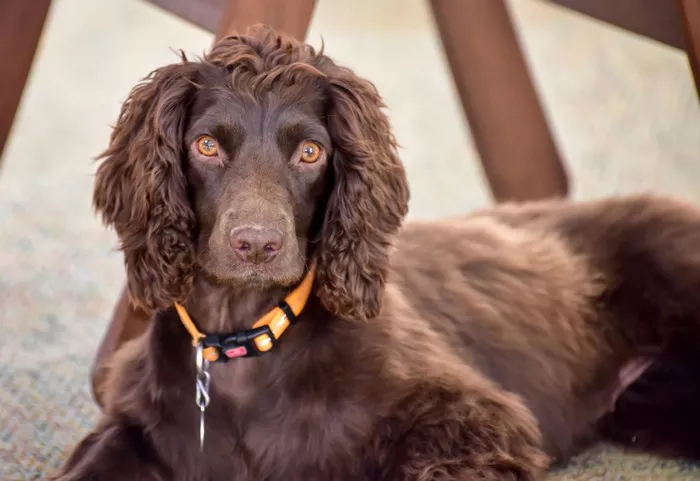Spaniels are a popular group of dogs that are known for their hunting abilities and affectionate personalities. Two spaniel breeds that are often compared are the Boykin Spaniel and the American Water Spaniel. While these breeds share some similarities, they also have some distinct differences. In this article, we will explore the characteristics of each breed and the differences between them.
Characteristics of the American Water Spaniel:
The American Water Spaniel is a medium-sized breed that was developed in the United States. These dogs have a curly or wavy coat that is typically brown or liver-colored. They are known for their hunting abilities, particularly in waterfowl hunting. American Water Spaniels are also intelligent and trainable dogs that make great family pets.
One of the most notable characteristics of the American Water Spaniel is their webbed feet. These feet are an adaptation that allows them to swim more efficiently. American Water Spaniels are also known for their high energy level and require plenty of exercise to stay healthy and happy.
Characteristics of the Boykin Spaniel:
The Boykin Spaniel is a small to medium-sized breed that was developed in South Carolina. These dogs have a curly or wavy coat that is typically brown or liver-colored. They were originally bred for hunting wild turkeys, but they are also used for hunting waterfowl and upland game birds.
Boykin Spaniels are known for their friendly and affectionate personalities. They are intelligent and trainable dogs that make great family pets. Boykin Spaniels are also energetic dogs that require plenty of exercise to stay healthy and happy.
Differences Between Boykin Spaniel and American Water Spaniel:
While Boykin Spaniels and American Water Spaniels share some similarities, there are also some notable differences between the two breeds. One of the most significant differences is their size. Boykin Spaniels are generally smaller than American Water Spaniels, with an average weight of 25 to 40 pounds compared to the American Water Spaniel’s average weight of 30 to 45 pounds.
Another difference between the two breeds is their hunting abilities. While both breeds are used for hunting, American Water Spaniels are particularly well-suited for waterfowl hunting due to their webbed feet. Boykin Spaniels, on the other hand, were originally bred for hunting wild turkeys and may be better suited for upland game bird hunting.
Personality is another area where the two breeds differ. While both Boykin Spaniels and American Water Spaniels are friendly and affectionate dogs, Boykin Spaniels are known for being more outgoing and social. American Water Spaniels, on the other hand, may be more reserved with strangers.
Conclusion:
Boykin Spaniels and American Water Spaniels are two spaniel breeds that share some similarities but also have some distinct differences. While both breeds are known for their hunting abilities and affectionate personalities, Boykin Spaniels are generally smaller and may be better suited for upland game bird hunting, while American Water Spaniels are larger and are particularly well-suited for waterfowl hunting. Personality is another area where the two breeds differ, with Boykin Spaniels being more outgoing and social and American Water Spaniels being more reserved with strangers. If you are considering getting a spaniel, it is important to research both breeds and choose the one that best fits your lifestyle and needs.
FAQs
1. What two breeds make a Boykin Spaniel?
The Boykin Spaniel is a unique breed that originated in the United States. It was developed by crossing several breeds, including the American Water Spaniel, Chesapeake Bay Retriever, Cocker Spaniel, and Springer Spaniel. However, the two primary breeds that contributed to the development of the Boykin Spaniel are the American Water Spaniel and the Cocker Spaniel. These breeds were selected for their hunting abilities, intelligence, and adaptability, resulting in the creation of the versatile and energetic Boykin Spaniel.
2. Is a Boykin Spaniel the same as a Cocker Spaniel?
No, a Boykin Spaniel is not the same as a Cocker Spaniel, although they share some similarities in appearance. Both breeds are medium-sized spaniels with long ears and expressive eyes, but they have distinct differences in terms of origin, temperament, and purpose. The Boykin Spaniel originated in the United States and was bred specifically for hunting and retrieving game in the swamps and marshes of South Carolina. In contrast, the Cocker Spaniel has English origins and was traditionally bred for flushing and retrieving game birds. While both breeds make excellent companions, the Boykin Spaniel is known for its exceptional hunting abilities and its affectionate, eager-to-please nature.
3. Do Boykin Spaniels have hair or fur?
Boykin Spaniels have a coat that consists of hair rather than fur. Their single-layered coat is moderately long, dense, and water-repellent, providing protection against the elements while hunting in marshy terrain. The Boykin Spaniel’s coat requires regular grooming to prevent matting and tangling, as well as to remove loose hair and debris. While shedding is minimal compared to breeds with double coats, Boykin Spaniels still require routine brushing and occasional baths to keep their coat healthy and clean.
4. What are the behavior problems with Boykin Spaniels?
Boykin Spaniels are generally well-behaved and eager to please, but like all breeds, they may exhibit certain behavior problems if not properly trained and socialized. Some common behavior issues that may arise in Boykin Spaniels include excessive barking, digging, and chewing, especially if they become bored or under-stimulated. Additionally, without proper exercise and mental stimulation, Boykin Spaniels may develop destructive behaviors or become overly anxious. Consistent training, positive reinforcement, and regular exercise are essential for managing and preventing behavior problems in Boykin Spaniels. Additionally, providing them with plenty of opportunities for mental and physical stimulation, such as interactive toys, obedience training, and outdoor activities, can help channel their energy in a positive direction.


